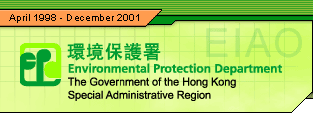|
Content
> Seeing It Through To The End
> EIA Follow Up > Enforcing
the Ordinance on a Territory-wide Basis > Enforcement
Figures and Prosecution
EIA
Follow Up
Within the framework
of environmental permit conditions, there are generally three areas
of requirement provided for the continuation of EIA follow up.
1. Review
of Detailed Design and Management Plan
At the time
an environmental impact assessment is conducted, projects are often
at the conceptual or feasibility stages. Often the detailed design
of the project is not yet available. Some detailed designs can include
mitigation measures such as placement of acoustic barriers, contaminated
waste treatment, landscaping measures in addition to the temporary
structures needed for construction of the project. A management
plan also covers environmental issues during the construction stage
of the project such as construction waste, ecological preservation
or construction plants.
To preempt any
deviation from EIA recommendations and findings, the Director requires
both the detailed design and management plan to be submitted to
follow up.
2. Environmental Monitoring and Audit (EM&A)Program
Since its pioneering
use in the Airport Core Projects from 1992, the fundamental role
of the EM&A program for following through on EIA study recommendations
was further enhanced by the Ordinance when it became a statutory
requirement. These requirements are often found in the form of an
EM&A manual accompanying the EIA report and are stipulated in
the subsequent environment permit when issued.
Environmental
monitoring involves a systematic collection of data, for the purpose
of determining the baseline, impact and compliance of the project.
Environmental auditing comprises the audit of mitigation measures,
design changes and compliance against legislative requirements and
standards.
Although the
parameters or impacts to be monitored are highly project specific
and variable with different stages of a project, monitoring data
are compared against trend indicators comprising on "action
level" and "limit level" of environmental quality
performance limits. Should monitoring results go beyond these limits,
action will be taken according to the action plan set for these
limits.
With regular
reporting requirements from the monitoring program stipulated in
every environmental permit, both identified mitigation measures
and unanticipated severe impacts of the project can be more closely
followed.
If any of the
EM&A requirements are violated, a warning may be issued or prosecution
actions taken against the project proponent and permit holders.
3. Submission of Certified Reports on Mitigation Measures Implemented
-Use of Independent Environmental Checkers (IEC)
The provision
of project information is primarily the responsibility of the permit
holder's environmental team. To avoid any bias due to conflict of
interest, which may affect the reliability of the information submitted
to the Director of Environmental Protection, another tier of checking
is introduced into the system in the form of the Independent Environmental
Checker (IEC).
Under this arrangement,
project proponents are required to employ an IEC to audit the monitoring
by the permit holder or his agent. The IEC will also check and certify
reports on the status of the implementation and completion of mitigation
measures as recommended in the EIA report.
As an additional
measure of quality control, the qualification of the environmental
team leader and IEC are also specified in every environmental permit.
|


